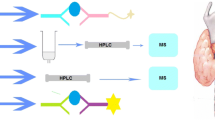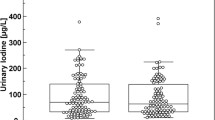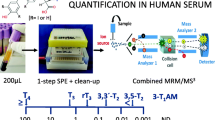Abstract
A method for the determination of free iodide in human serum was developed. For this purpose iodide from pooled serum samples was separated from the organic manner by SEC. The iodide fraction subsequently was freezedried and analyzed by ion chromatography for quantification. Investigations for recovery and precision were carried out and were found to show sufficient results. For quality assurance ICP-MS was taken additionally as an total I-detector [1], using native and iodide-spiked serum samples. The iodide results of ICP-MS as well as those of IC were well corresponding. Iodine containing SEC-fractions from iodide-spiked samples showed no increased I-values except that in the iodide fractions, proving that there was no iodide conversion into other I-species (and vice versa) during the whole procedure.
Free iodide from two serum pools of different healthy persons was determined as 2.25 and 2.43 μg I−/L, respectively. The values are related to total iodine levels determined by ICP-MS. For comparative reasons a table of individual iodine and iodide values is presented.
Similar content being viewed by others
Abbreviations
- IC:
-
ion chromatography
- ICP-MS:
-
inductively coupled plasma mass spectrometry
- LPLC:
-
low pressure liquid chromatography
- PED:
-
pulsed electrochemical detector
- SEC:
-
size exclusion chromatography
- RT:
-
retention time
References
P. Schramel, S. Hasse,Mikrochim. Acta 1994,116, 205.
E. J. Underwood,Trace Elements in Human and Animal Nutrition, 4th Ed. Academic Press, New York, 1977.
A. S. Prasad,Trace Elements and Iron in Human Metabolism, Plenum, New York, 1978.
W. Buchberger,J. Chromat. 1988,439, 129.
H. Keller,Klinisch-chemische Labordiagnostik für die Praxis, Thieme, Stuttgart, 1991.
J. T. Dunn, H. E. Crutchfield, R. Gutekunst, A. D. Dunn,Thyroid,1993,3, 119.
K. Müller,Clin. Chim. Acta 1967,17, 21.
E. Makowetz, K. Müller, H. Spitzy,Microchem. J. 1966,10, 194.
B. Michalke, D. C. Münch, P. Schramel,J. Trace Elem. Electrolytes Health Dis. 1991,5, 251.
G. V. Iyengar,Elemental Analysis of Biological Systems, Vol. 1, CRC, Boca Raton, 1987.
W. Buchberger, U. Huebauer,Mikrochim. Acta 1989,3, 137.
S. K. Nath, B. Moinier, F. Thuillier, M. Rongier, J. F. Desjeux,Internat. J. Vitamin Nutr. Res. 1992,62, 66.
Author information
Authors and Affiliations
Rights and permissions
About this article
Cite this article
Michalke, B., Schramel, P. & Hasse, S. Determination of free iodide in human serum: Separation from other I-species and quantification in serum pools and individual samples. Mikrochim Acta 122, 67–76 (1996). https://doi.org/10.1007/BF01252407
Received:
Revised:
Issue Date:
DOI: https://doi.org/10.1007/BF01252407




